Crassula dependens
Crassula dependens Bolus.
Family: Crassulaceae
Common names: slab stonecrop (Eng.); lengoako , sevelilenyana, setsosa (South Sotho)
Introduction
Crassula dependens is a delicate yet striking mat-forming succulent, known for its slender, branching stems and colourful, sharply pointed leaves that range from green to reddish hues. In summer, it puts on a charming display of tiny white to cream tubular flowers clustered at the tips of its stems, making it a standout addition to any rockery or succulent garden.
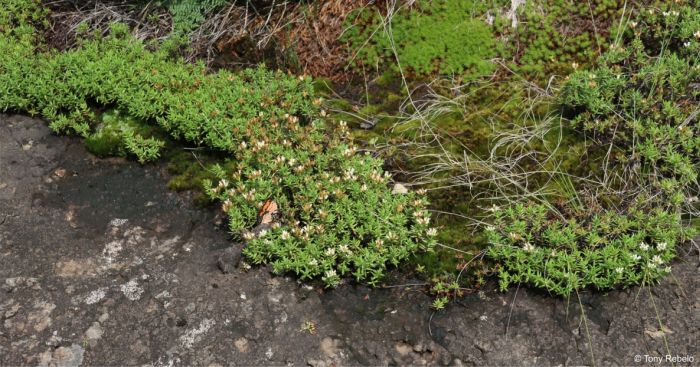
Description
Description
Crassula dependens is a small, evergreen shrub that grows up to 200 mm in height. The stems are decumbent to prostrate, moderately branched, and develop from a central base. Young stems are covered with fine, hair-like outgrowths, while older stems become woody with a brown, bark-like surface. The leaves are hairless, succulent, and arranged oppositely along the stems. They are narrow and lance-shaped with sharply pointed tips, measuring 5–15 mm in length and 1–2 mm in width. Leaf colours vary from green to brown, and sometimes red. The inflorescence is a nearly flat-topped cluster of small, tubular flowers borne on short stalks. The flowers are white to cream in colour and appear in dense heads in late summer (from January to March). Each flower consists of five petals with pointed, triangular tips that curve backward. The outer surface of the petals have fine ridges. Inside the flower, dark anthers are visible, containing pollen. Green sepals with pointed tips surround the base of each flower, protecting the bud and supporting the petals when in bloom. After flowering, small, dry fruits called follicles develop. These contain tiny seeds, which are dispersed by wind once mature.
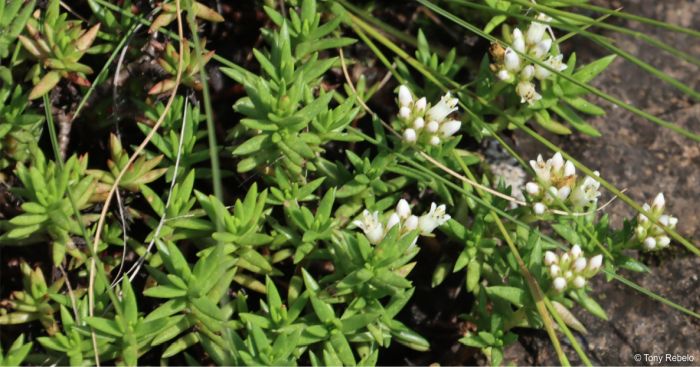
Conservation Status
Status
Crassula dependens is assessed as Least Concern (LC) on the Red List of South African plants.
Distribution and habitat
Distribution description
Crassula dependens is indigenous to South Africa and has a relatively wide distribution across several provinces. It naturally occurs in the Western Cape and extends into parts of the Eastern Cape, Northern Cape, KwaZulu-Natal, Free State, and Mpumalanga. However, it is absent from Limpopo, Gauteng and the Northwest. Its presence in both winter and summer rainfall regions highlights its adaptability to diverse climatic conditions.
This species typically grows in well-drained, rocky environments. It is often found on rocky outcrops, grassland slopes, and the margins of forests. In the Drakensberg region, it occurs on moist rock ledges, while in drier areas such as the Karoo, it can be seen growing on exposed rocky ridges. Crassula dependens is especially well adapted to semi-arid conditions and is commonly associated with habitats that receive seasonal rainfall.
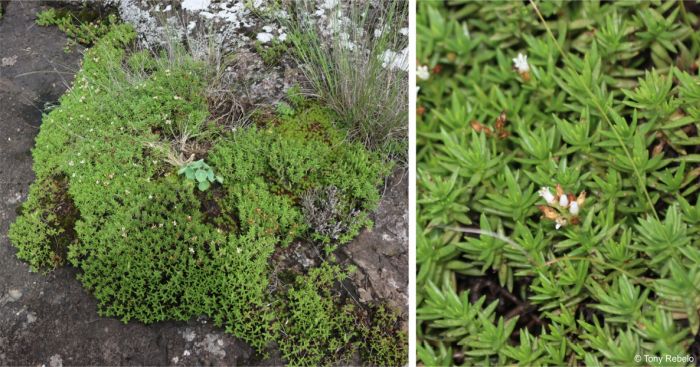
Derivation of name and historical aspects
History
The genus name Crassula is derived from the Latin crassus, meaning ‘thick’ or ‘fat’, and refers to the thick, fleshy leaves that characterize many species in this genus. The species name dependens is Latin for ‘hanging’, ‘drooping’, or ‘dependent’, describing the plant's trailing or sprawling growth habit, often seen cascading over rocks or hanging over the edges of containers. Crassula dependens is a South African succulent species within the Crassulaceae, commonly known as the stonecrop family.
This family is composed primarily of fleshy-leaved succulents adapted to arid environments and is widely distributed across the globe, particularly in southern Africa. Members of this family are well known for their ability to store water in their leaves and stems, helping them survive in rocky, drought-prone habitats. Crassulaceae is a large and ecologically significant family, containing about 35 genera and approximately 1 500 species worldwide. It plays a particularly important role in the arid Succulent Karoo Biome, where it is the seventh largest family, and is the second-largest group of leaf-succulents in southern Africa, after the Aizoaceae. Several members are also known for their use in horticulture, traditional medicine, and as ornamental plants.
The genus Crassula is one of the most diverse and horticulturally significant genera within the family. It comprises more than 300 species, with the highest concentration in southern Africa, especially in the Cape Floristic Region. Species within this genus range from compact groundcovers and trailing herbs to small shrubs, and while most produce small flowers, some exhibit striking floral displays in shades of white, pink, yellow, or red.
Crassula dependens is often confused with Crassula tetragona, another member of the genus. However, it can be distinguished by its narrow, oval leaves and the presence of fine, hair-like outgrowths on its young stems. Its small white to cream flowers are carried on short stalks in compact clusters. Geographically, C. dependens is found across a broad range from the Western Cape, Northern Cape, and Free State to KwaZulu-Natal, Mpumalanga, and parts of the Eastern Cape while C. tetragona is more narrowly distributed in KwaZulu-Natal, Mpumalanga, and the Free State.
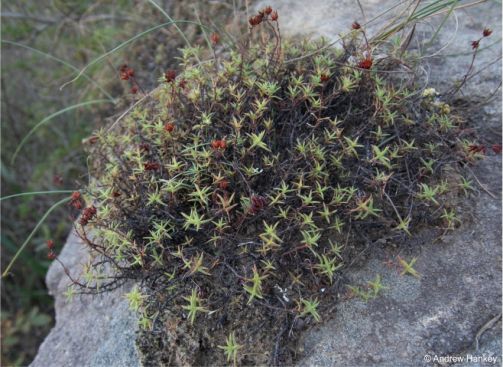
Ecology
Ecology
Crassula dependens is well adapted to dry environments. It uses a special method of photosynthesis called CAM (Crassulacean Acid Metabolism), which helps it save water. Unlike most plants that take in air during the day, Crassula opens tiny pores in its leaves at night to take in carbon dioxide and stores it until the next day. This helps the plant survive in hot, dry conditions. In very dry times, it can even stop taking in air and recycle what it already has inside helping it stay alive, though it won’t grow during that time.
This plant is also tough. It can grow roots from its stem or even a single leaf, so if it is damaged or knocked over, it can regrow easily. Leaves that fall off can grow into new plants. The small white to cream flowers attract many insects like bees, wasps, butterflies, beetles, and flies, which help pollinate the plant. After flowering, it makes tiny seeds that are spread by the wind. Animals like tortoises eat the leaves, but usually don’t harm the whole plant. Its stems also provide safe places for wasps to build their nests.
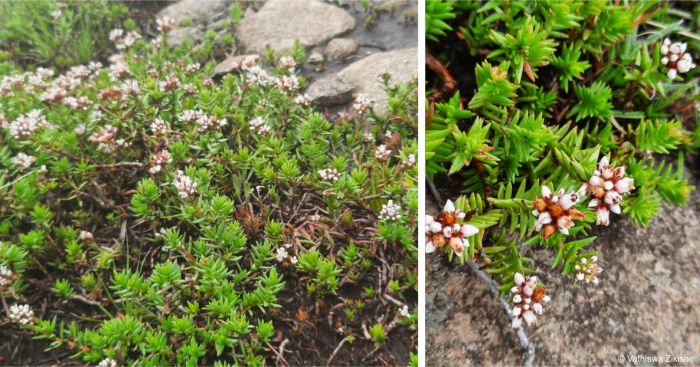
Uses
Use
Many Crassula species are widely valued for both medicinal and ornamental purposes. Traditionally, the roots are ground into powder and used to treat wounds, diarrhoea, heartburn, hysteria, and other ailments. Some species are also used to manage epilepsy, act as a laxative, or treat corns. In Zulu culture, Crassula dependens is planted as a protective charm against lightning. Horticulturally, it is grown for its decorative appeal in gardens, pots, and hanging baskets. Its trailing stems make it ideal for groundcover and for helping to prevent soil erosion on slopes or embankments.
Growing Crassula dependens
Grow
Crassula dependens is easy to propagate and suitable for beginners. Common methods include seed sowing, leaf and stem cuttings, and division. Seeds are tiny and best sown in early spring or late summer on well-drained sandy loam enriched with compost. Lightly cover seeds (about 3 mm) and keep moist in bright, indirect light; germination takes 14–20 days. For leaf cuttings, detach a healthy leaf and allow it to callus for 2–3 days. Place it in coarse sand or a sandy potting soil mix, keep the soil slightly moist, and provide indirect light. Roots appear within 2–3 weeks. Take stem cuttings, 8–10 cm long, also allow to callus for a few days before planting in the same mix; rooting hormone is not required. Water sparingly until established. Division suits mature mats—carefully separate rooted sections and replant in well-draining soil. Keep divided plants in partial shade for a week to reduce transplant shock.
Crassula dependens thrives in full sun to partial shade and is suitable for indoor containers or outdoor beds. Outdoors, morning sun with afternoon shade is ideal, especially in hot climates. It prefers well-draining sandy or loamy soils with a neutral to slightly acidic pH (6.0–7.5). Avoid heavy or waterlogged soils to prevent root rot. Water only when the soil is dry—about every 10–14 days in summer and less in winter. Overwatering causes yellowing and soft leaves; withhold water until recovery. Feed with a diluted succulent fertilizer every 4–6 weeks during the growing season. The plant tolerates light frost in sheltered spots but should be protected or moved indoors in areas with severe frost. It grows slowly and requires minimal pruning; pinching leggy stems encourages bushier growth.
It is ideal for rock gardens, hanging baskets, retaining walls, and as a trailing groundcover. Its fine stems soften edges and help control erosion on slopes. Pair with drought-tolerant succulents like Delosperma, Portulacaria or compact species of Aloe for textural contrast. It is not suited for lawns or formal hedges but fits well in informal, naturalistic plantings.
Crassula dependens is generally hardy but susceptible to fungal diseases such as leaf spot and root rot in wet or humid conditions. Ensure good drainage and air circulation, avoid overhead watering, and remove infected tissue promptly. Spider mites may infest dry indoor plants, causing yellowing and webbing. Control by increasing humidity, wiping leaves, or applying insecticidal soap. Maintain plant health by avoiding overwatering, removing dead leaves, and fertilizing lightly during the growing season.
References
- Hankey, A. 2024-May. Observation of Crassula dependens, Chris Hani, EC. iNaturalist. Online. https://www.inaturalist.org/observations/218889938.
- Hutchings, A., Scott, A.H., Lewis, G. & Cunningham, A.B. 1996. Zulu medicinal plants: an inventory. University of Natal Press, Pietermaritzburg.
- Malan,C. & Notten, A. 2005. Crassula ovata (Miller) Druce (Crassulaceae). PlantZAfrica. Online. https://pza.sanbi.org/crassula-ovata.
- Moeketsane, T. & Notten, A. 2023. Crassula tetragona L. (Crassulaceae). PlantZAfrica. Online. https://pza.sanbi.org/crassula-tetragona.
- Nichols, G. 2005. Growing rare plants: a practical handbook on propagating the threatened plants of southern Africa. Southern African Botanical Diversity Network Report No. 36.
- Pooley, E. 1998. A field guide to wild flowers of Kwazulu-Natal and the eastern region. Natal Flora Publications Trust, Durban.
- Raimondo, D., Von Staden, L., Foden, W., Victor, J.E., Helme, N.A., Turner, R.C., Kamundi, D.A. & Manyama, P.A. (eds) 2009. Red list of South African plants. Strelitzia 25. South African National Biodiversity Institute, Pretoria.
- Rebelo, T. 2025-Feb. Observation of Crassula dependens, Drakensberg, KZN. iNaturalist. Online. https://www.inaturalist.org/observations/261891465.
- Snowball, J. 2023. Everything you need to know about Crassula plants. Gardens Illustrated. Online. https://www.gardensillustrated.com/plants/house-plants/crassula-grow-guide.
- Wentzel, J. 2025. Crassula dependens. Wildflower Nursery. Online. https://wildflowernursery.co.za/indigenous-plant-database/crassula-dependens/.
- Zikishe, V. 2023-Feb. Observation of Crassula dependens, Amathole district, EC. iNaturalist. Online. https://www.inaturalist.org/observations/150129170.
Credits
Sihle Mvunyiswa, Thembeka Blose, Sethabile Mntambo and Lungisani Zondi
KwaZulu-Natal National Botanical Garden
July 2025
Acknowledgements: images by Andrew Hankey, Tony Rebelo and Vathiswa Zikishe.
Plant Attributes:
Plant Type: Ground Cover, Succulent
SA Distribution: Eastern Cape, Free State, KwaZulu-Natal, Mpumalanga, Northern Cape, Western Cape
Soil type: Sandy, Loam
Flowering season: Late Summer
PH: Acid, Neutral
Flower colour: White, Cream
Aspect: Full Sun, Morning Sun (Semi Shade), Afternoon Sun (Semi Shade)
Gardening skill: Easy
Special Features:
Horticultural zones










Rate this article
Article well written and informative
Rate this plant
Is this an interesting plant?
Login to add your Comment
Back to topNot registered yet? Click here to register.